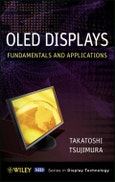A much–needed guide to the design and manufacturing of OLED displays
Organic Light–Emitting Diode (OLED) displays are expected to replace Liquid Crystal Displays (LCDs) in the upcoming years in television screens, computer monitors, watches, mobile phones, and similar applications. OLED Displays: Fundamentals and Applications is the first book to offer complete, practical, up–to–date coverage of the development, manufacturing, and applications of this cutting–edge technology.
Written by a leading industry expert with over two decades in both R&D and commercialization, the book walks engineers and industry professionals through all aspects of the technology, from the basics of OLED displays to commercialization and manufacturing. Drawing on extensive firsthand experience, the author explains the fundamentals of OLED composition and function, details step by step the design and manufacturing of OLED displays, and examines important applications in lighting and display technology. He also provides real–world examples and problem–solving techniques used during product commercialization.
Geared to both experienced practitioners and newcomers to the field, OLED Displays: Fundamentals and Applications:
-
Discusses emission mechanisms, material selection, device processing, manufacturing issues, and display design basics
-
Outlines Thin Film Transistor (TFT) backplane design and processing details, including the Low Temperature Poly Silicon (LTPS) process and circuit integration
-
Devotes a full chapter to lighting, one of the major applications of OLED
-
Explores a variety of display applications, including flexible displays and the large–scale OLED television screen
-
Covers both the current composition of OLED and the future of OLED technologies and displays
Table of Contents
Series Editor′s Foreword ix
Preface xi
1 Introduction 1
2 OLED Display Structure 5
2.1 OLED Definition 5
2.2 OLED Device Principles and Mechanisms 8
2.2.1 Basic Device Structure 8
2.2.2 Light Emission 10
2.2.3 Emission Efficiency 26
2.2.4 Lifetime and Image Burning 30
3 OLED Manufacturing Process 37
3.1 Material Preparation 37
3.1.1 Basic Material Properties 37
3.1.2 Purifi cation Process 41
3.2 Evaporation Process 42
3.2.1 Principle 42
3.2.2 Evaporation Sources 47
3.3 Shadow Mask Patterning 54
3.4 Encapsulation 57
3.4.1 Dark Spot and Edge Growth Defects 57
3.4.2 Light Emission from the Bottom and Top of the OLED Device 58
3.5 Problem Analysis 61
3.5.1 Ionization Potential Measurement 61
3.5.2 HPLC Analysis 64
3.5.3 Cyclic Voltammetry 65
4 OLED Display Module 69
4.1 Comparison between OLED and LCD Modules 69
4.2 Basic Display Design and Related Characteristics 71
4.2.1 Luminous Intensity, Luminance, and Illuminance 71
4.2.2 OLED Current and Power Efficiencies 76
4.2.3 Color Reproduction 80
4.2.4 Uniform Color Space 87
4.2.5 White Point Determination 88
4.3 Passive–Matrix OLED Display 91
4.3.1 Structure 91
4.3.2 Pixel Driving 93
4.4 Active–Matrix OLED Display 96
4.4.1 OLED Module Components 96
4.4.2 Two–Transistor One–Capacitor (2T1C) Driving Circuit 97
4.4.3 Ambient Performance 100
4.4.4 Subpixel Rendering 101
5 TFT Substrate for OLED Driving 105
5.1 TFT Structure 105
5.2 TFT Process 110
5.2.1 Low–Temperature Polysilicon Process Overview 110
5.2.2 Thin–Film Formation 111
5.2.3 Patterning Technique 112
5.2.4 Excimer Laser Crystallization 116
5.3 MOSFET Basics 120
5.4 LTPS–TFT–Driven OLED Display Design 122
5.4.1 OFF Current 123
5.4.2 Driver TFT Size Restriction 124
5.4.3 Restriction Due to Voltage Drop 125
5.4.4 LTPS–TFT Pixel Compensation Circuit 132
5.4.5 Circuit Integration by LTPS–TFT 139
6 Next–Generation OLED Technologies 143
6.1 Color–Patterning Technologies 143
6.1.1 White + Color Filter Patterning 143
6.1.2 Color Conversion Medium (CCM) Patterning 145
6.1.3 Laser–Induced Thermal Imaging (LITI) Method 145
6.1.4 Radiation–Induced Sublimation Transfer (RIST) Method 146
6.1.5 Dual–Plate OLED Display (DOD) Method 148
6.1.6 Other Methods 150
6.2 Solution–Processed Materials and Technologies 151
6.3 Next–Generation OLED Manufacturing Tools 155
6.3.1 Vapor Injection Source Technology (VIST) Deposition 155
6.3.2 Hot–Wall Method 159
6.3.3 Organic Vapor–Phase Deposition (OVPD) Method 162
6.4 OLED Television Applications 162
6.4.1 Performance Target 163
6.4.2 High–Yield Manufacturing by White + Color Filter Method 164
6.5 Next–Generation TFT Technologies for OLED Display 175
6.5.1 Sequential Lateral Solidifi cation (SLS) Method 175
6.5.2 Microcrystalline and Superamorphous Silicon 176
6.5.3 Solid–Phase Crystallization 178
6.5.4 Oxide Semiconductors 181
7 OLED Lighting 187
7.1 Color Rendering Index 187
7.2 OLED Lighting Requirement 191
7.2.1 Correlated Color Temperature (CCT) 191
7.2.2 Other Requirements 192
7.3 Light Extraction Enhancement 197
7.3.1 Microlens Array Structure 197
7.3.2 Diffusion Structure 198
7.3.3 Diffraction 200
7.4 OLED Lighting Design 200
7.4.1 Resistance Reduction 201
7.4.2 Current Reduction 201
8 New OLED Applications 205
8.1 Flexible Display 205
8.1.1 Flexible Display Applications 205
8.1.2 Barrier Technology for Flexible Displays 205
8.1.3 WVTR Measurement 208
8.1.4 Organic TFTs for Flexible Displays 210
8.2 Transparent 215
8.3 Tiled Display 217
8.3.1 Passive–Matrix Tiling 217
8.3.2 Active–Matrix Tiling 220
Appendix 225
About the Author 229
Index 231
Reviews
Overall however, despite a few shortcomings, this work will be a valuable and currently unique resource for anyone interested in learning about OLEDs in general and of particular interest to engineers, managers, and other industry professionals entering the field or expanding their areas of expertise. (Information Display, 1 May 2012)








